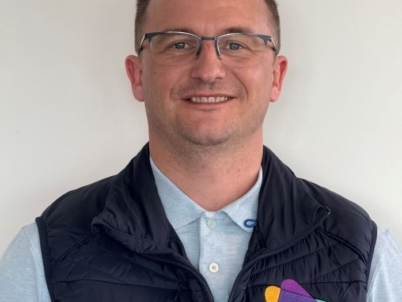-
BLACKOUT TECHNOLOGIES TARGETS TELEMATICS-INTEGRATED MOBILE DEVICE BLOCKING TO COMBAT SMARTPHONE DISTRACTION - April 1, 2025
-
OpenADR Alliance announces first OpenADR 3.0 certified products with EVoke Systems, E.ON Energy and Universal Devices - March 25, 2025
-
Growing fulfilment and contract packer appoints new Managing Director - March 25, 2025
-
When is it time to invest in a WMS? Understanding the key trigger points - March 25, 2025
-
eCapital helps Vantage Recruitment on its journey to financial success - March 24, 2025
-
Hugo Beck Celebrates 70 Years of Packaging Innovation with Open House Events - March 20, 2025
-
PROLOG FULFILMENT SUPPORTS LUNA DAILY’S COMMITMENT TO BETTER BODY CARE FOR ALL WOMEN - March 19, 2025
-
Motion Ventures launches largest-ever maritime tech fund at $100M to meet the industry’s new pace of adoption - March 18, 2025
-
ITD GLOBAL APPOINTS GROUP CHIEF REVENUE OFFICER - March 17, 2025
-
SURECAM TEAMS UP WITH ENTERPRISE FLEX-E-RENT FOR VEHICLE REPAIR & MAINTENANCE CONFERENCE - March 14, 2025
By Steve Purvis, Managing Director at Bis Henderson Space
Despite reports, the High Street isn’t dead. However, it is going through another of its periodic transformations – one which may have considerable impact not just on the use of retail space but on the requirements for the warehousing that supports the whole shopping experience.
Amid the angst about rows of empty shops and the demise of much-loved retail brands, it is easy to forget that the High Street has been through changes as fundamental, if not quite so rapid, many times before. For many decades now, family-owned shops have struggled to compete with the slicker supply chains of new national brands. Department stores threatened to suck trade from small towns to the big city. Self-service would deskill and depersonalise the retail experience, while edge-of-town hypermarkets and malls would draw in the affluent car-owning middle classes, leaving town centre retailers the privilege of paying ever-higher business rates to serve a low footfall of low spenders.
However, the High Street continually adapted and survived. Now there are new challenges: the inexorable rise of e-retail, with goods ordered from and delivered to the comfort of the customer’s home; and the drive to reduce carbon and other emissions and congestion in town centres making it increasingly difficult for retailers to receive deliveries, or for customers to get their shopping home.
Many town centres have, paradoxically, seen an increase in the number of small, independent, specialist or ‘artisan’ retailers, but there is no denying that the large ‘flagship’ or ‘anchor’ stores, fundamental to the thinking of town planners and property developers alike, have been hard hit. But the survivors are fighting back, developing new ways of becoming a ‘destination’ and rewiring the retail ‘experience’.
In the process, they could be said to be re-inventing the department store – indeed Next, which is expanding from fashion into home and beauty through both own-label and third-party brands, has actually taken over a former Debenhams store in Watford. On Oxford Street, Next is creating a ‘shop-in-shop’ for Gap as well as concessions ranging from Sockshop to 02, Lipsy, and Paperchase. Some Next stores are also offering garden products through Homebase concessions.
Sports Direct, part of Fraser Group, is similarly bringing together the group’s fashion, cycling, games, sports and other labels, and potentially other premium brands, in a single megastore in central Birmingham.
In Bristol, Harrods is taking the former BHS premises with an ‘H Beauty’ format selling ‘make-up, skincare and fragrance from a host of brands’. M&S, which famously used only to sell its own label products, now features external brands on its website and is introducing them to its physical estate, starting with Early Learning Centre and potentially also including Joules, Hobbs, Phase Eight, White Stuff, and Nobody’s Child.
Asda has upped its fashion offer both online and in store, beyond its in-house George brand, by carrying other brands such as Missguided and New Look. The supermarket is also introducing B&Q concessions in some of its stores and developing partnerships with the like of The Entertainer, Decathlon, and Claire’s Accessories.
Besides merchandise, retailers are also extending the ‘experience’ through hosting food and drink outlets – a commonplace in traditional department stores like John Lewis, but now often involving external brands, such as Costa Coffee at Next and Pret a Manger in Tesco.
Retailers and property owners/occupiers are taking subtly different approaches, but a common theme is the desire to share the burden of rents, rates, utility charges, and of logistics and inventory costs.
There are some important points here. Firstly, these are not crude sub-leases; they are partnerships or collaborations across the full range of retail, and more importantly from our point of view, logistics activities. That means, for example, that they will be finding and exploiting synergies in goods inwards deliveries, which also helps address the growing range of restrictions on freight traffic in town centres.
Similarly, they may also be looking for synergies in deliveries to consumers because, importantly, many of these developments do not envisage that the customer will necessarily be carrying their purchases away with them – although conversely, click’n’collect may also be an option.
Many of these concessions will be integrated with their host’s systems both online and in-store, and the retail space is envisaged as more of a showroom than a conventional shop. Consumers can touch and feel products, and perhaps, with both digital and human assistance, order and pay for home delivery of products from a mix of concessionaires – conceivably, the shopping could get home before the shopper.
Stores as destinations for a range of activities, not all of them directly related to shifting merchandise, will increasingly become the norm. Relatively little stock will be carried in store, freeing more space for displays and activities. The customer can tour the rest of the store, or other shops on the High Street, or get on a bus home, unencumbered by carrier bags, flat pack furniture and the rest. In effect it is another type of eCommerce, except that the customer is ordering using a device in store rather than in the sitting room.
But the demands for inventory storage, and for space to facilitate tightly timed fulfilment, are equivalent, and we recall that every £1 billion in eCommerce sales requires between 750,000 and 1 million sq. ft of warehouse space. Clearly, for maximum efficiency, or in some regions to operate this model at all, the host retailer and its partners will need to collaborate on warehousing and fulfilment – not just consolidated deliveries in unbranded or cobranded vehicles, but in storage, inventory management, order picking and the rest.
In an ideal world that might mean ten or a dozen partners sharing an edge of town facility feeding their last mile fulfilment. In practice, such are the levels of rent on warehousing around London and some other cities, this may not be economically possible, and more complex consolidation arrangements and more distant hubs may have to be used.
On the other hand, there may be situations where there is sufficient spare space on a large High Street retail site, even after an increase in display area, cafes, ancillary activities, to accommodate this sort of activity – to some extent this depends on the size of goods in question: fragrances are less of a challenge than furniture.
These are early days and the details of viable long-term business models are not yet entirely clear: there will be issues around gain sharing, governance, liability and the rest. Nonetheless, the High Street is, as always, reinventing itself. In the process it will raise the demand for warehousing, and for innovative approaches to the use of space, to even greater levels. Bis Henderson, with our wealth of experience in this field, can help new retail partners devise effective and robust solutions to this challenge.
More information on Bis Henderson Space at www.bis-hendersonspace.com

































